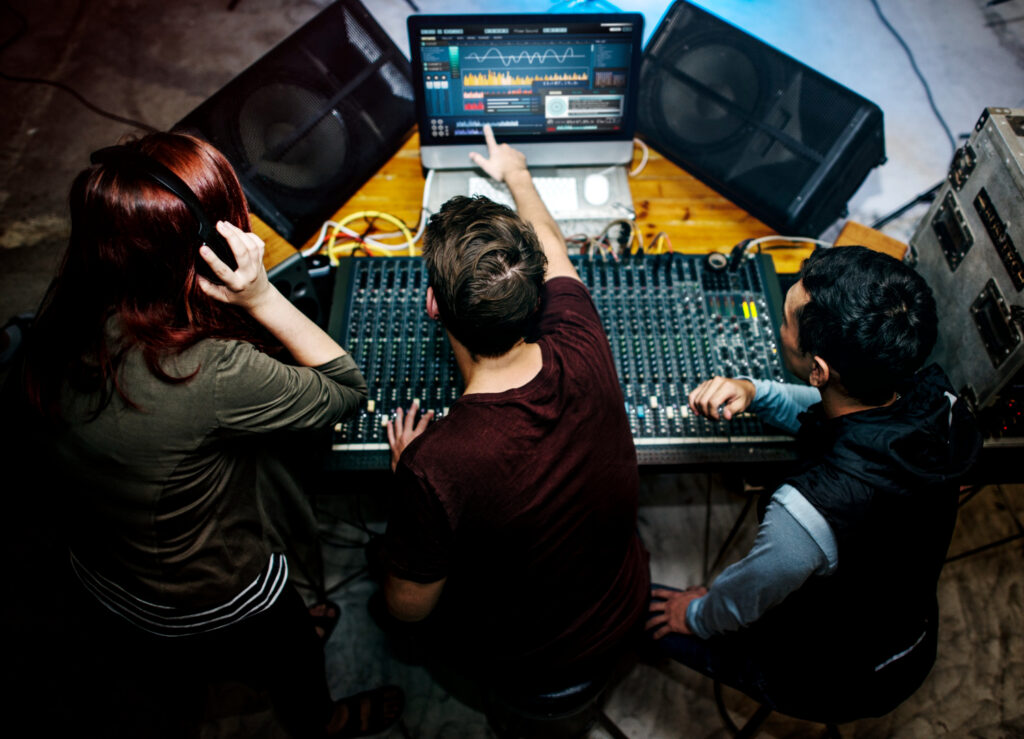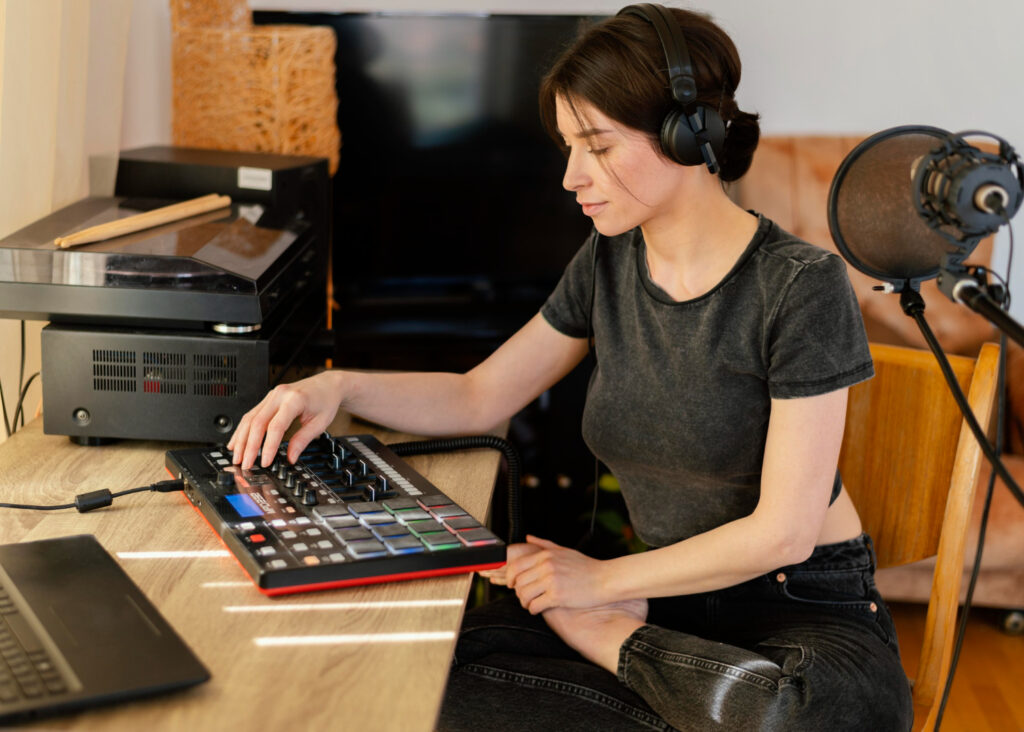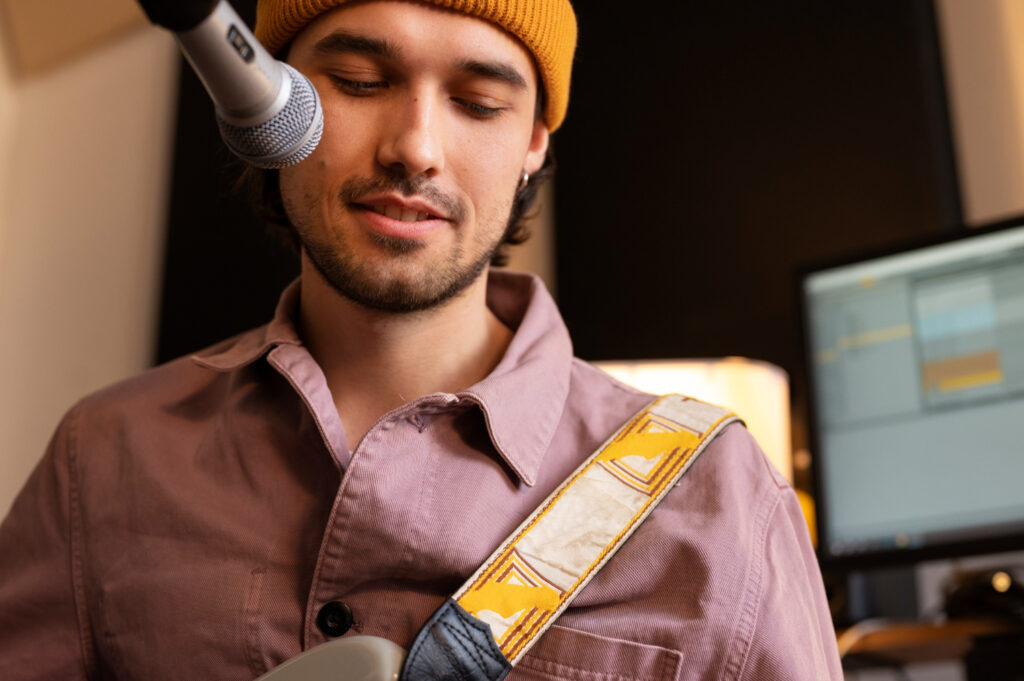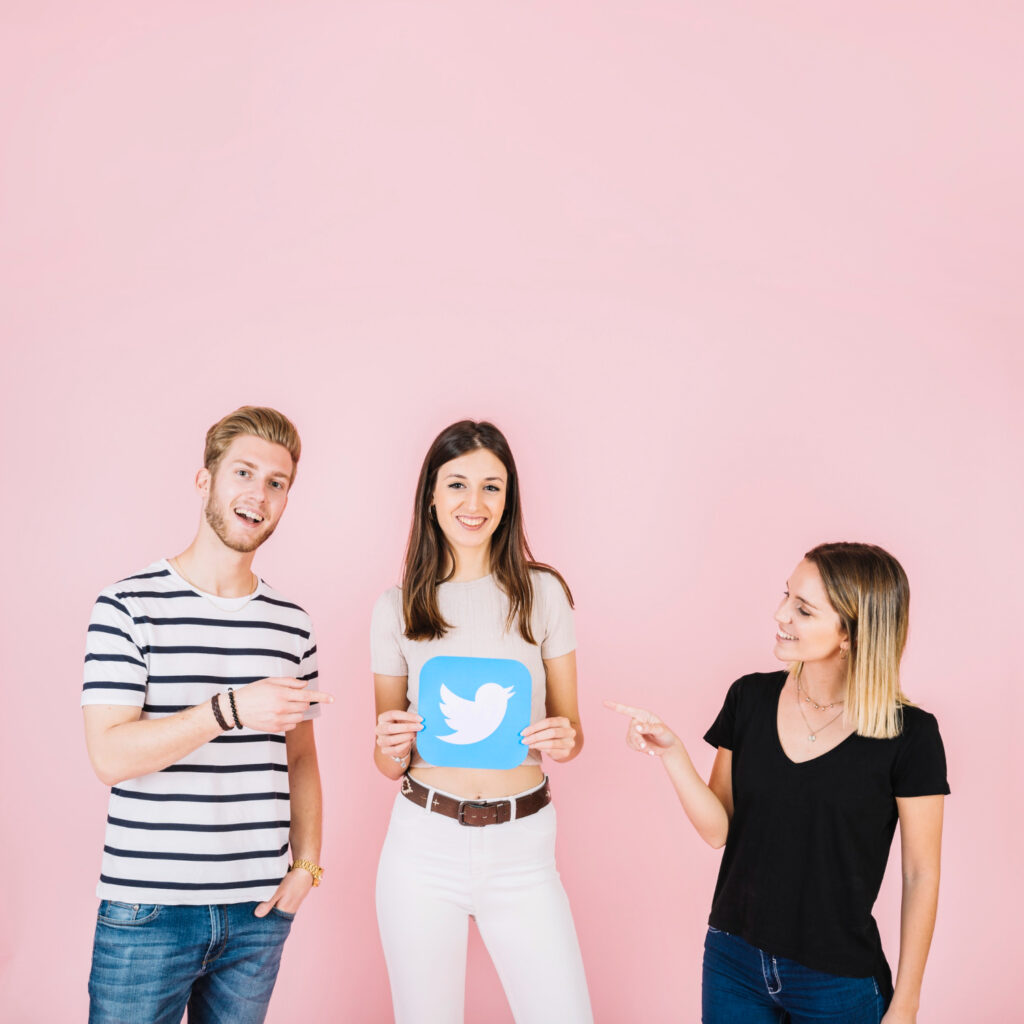About Eagle 3 Radio Station

Based on more than 20 years of establishing radio identities throughout Surrey and North-East Hampshire, Eagle 3 didn’t just appear; it developed. It was much more than a catchy homage to Apollo 11 when Peter Gordon famously announced, “Hey, I’ve landed,” at the beginning of the first broadcast in 1996. It was the clear beginning of something that felt grounded, local, and long-lasting. Since then, the station has successfully negotiated significant changes in the media landscape while maintaining a strong connection to its audience and remaining up to date.
The identity of the station has changed over time. Eagle 3 marks a bold new chapter for the station, which was first known as 96.4 The Eagle before changing its name to Eagle Radio. In addition to moving its offices, the station strengthened its civic ties by working with Guildford College. This move was especially creative because it gave students access to a live media environment like never before and established the station as an active participant in educational pathways.
Guildford College Group Principal Dr. Mike Potter CBE saw it clearly: this was a shared vision, not just real estate. Since then, the collaboration has shown itself to be very effective, giving students practical experience in scripting, production, and even on-air appearance. Eagle 3 created a useful media incubator on campus by combining broadcasting and education, greatly reducing the conventional divide between theory and practice.
Eagle 3 continues to be a unique success in the context of the UK’s declining local media. This station amplifies the community’s street-level pulse, whereas big commercial stations aggregate playlists and hire voices. In contrast to algorithm-fed chart shows, its programming features unsigned artists, many of whom play at neighborhood cafés or open-mic nights. Because of how adaptable that method is, a wider variety of genres and moods can authentically fill the airwaves.
Eagle 3 filled in during the pandemic when many local broadcasters cut back, airing voice messages from families in quarantine, local volunteer efforts, and mental health advice. This endeavor felt more like camaraderie than a public service announcement. Sincere, impromptu, and grounded, that tone has come to define the station.
One weekend, a segment about a 16-year-old Farnham singer-songwriter really resonated. With just a laptop and a borrowed microphone, she recorded her song in a bedroom. It was so well-received by listeners that the station played it again the next morning. She was performing as the opening act for a local music festival a few months later. It was a much faster trajectory than even she had expected. The Eagle 3 bump, as some now refer to it, is a platform that is changing the way that talent is found, not just a coincidence.
Many expected a move toward mainstream formatting after Bauer Media purchased the station in 2019. As an alternative, the team stuck to its fiercely local structure, which has turned out to be a very wise choice. Instead of watering down the programming to fit corporate templates, the team created Eagle 3 as a soulful digital-first platform. They increased reach without sacrificing tone by forming strategic alliances that included mobile integration and podcast syndications.
Eagle 3’s playlist is chosen based on cultural timing as well as popularity metrics. On a recent Tuesday, the lineup alternated between Britpop classics, Afrobeat, and indie folk, all connected by off-script jokes, birthday shoutouts, and local anecdotes. Listeners return for unexpected moments rather than well-known songs because of that erratic yet emotionally cohesive flow.
One of the many voices that formerly influenced Eagle’s legacy is Leona Graham, who is currently with Absolute 80s. Her career path demonstrates how this station develops media professionals in addition to music. Such an impact on the industry is subtly potent. Alumni from the Eagle 3 network have made appearances on the BBC, ITV, and various podcasting platforms worldwide over the last ten years, but nearly all attribute their storytelling prowess to their early Guildford studio days.
Eagle 3 and other stations have recently been reassessed as cultural infrastructure. They do more than just broadcast; they also mirror, reflect, and occasionally even reroute the emotional currents within their communities. Eagle 3 offers more than just music—a sonic canvas where lives are recognized and rhythms become memories—whether it’s a retiree remembering a Fleetwood Mac vinyl or a teenager struggling with exam anxiety.
Eagle 3’s refusal to give up personality is what makes it so resilient. This station demands names, voices, and dialogue in a digital age characterized by anonymous hosts and automatically generated playlists. That decision has paid off. Eagle 3 scores exceptionally well on listener trust and emotional connection, two metrics that national broadcasters find difficult to sustain, according to listener surveys.
The station’s incorporation of contemporary technologies, such as voice assistants and smartphone apps, has significantly increased user accessibility. Eagle 3 is more focused on what’s relevant than tech-driven platforms that promote what’s popular. That strategy gives medium-sized towns, where culture sometimes feels underappreciated, the visibility they need.
| Feature | Description |
|---|---|
| Station Name | Eagle 3 Radio |
| Location | Guildford College Campus, Surrey, England |
| Broadcast Area | Surrey and North-East Hampshire |
| Original Launch Date | 4 January 1996 (as 96.4 The Eagle) |
| Current Branding | Eagle 3 |
| Format | Pop, Rock, Local and Unsigned Artists |
| Previous Owner | UKRD Group |
| Current Owner | Bauer Media |
| Website | www.eaglemedia.com |
| Signature Personalities | Peter Gordon, Leona Graham |
| Community Role | Promoting youth talent, education collaboration, and local event |
Latest
The daughter of UEFA President Aleksander Čeferin, Petra Čeferin, has distinguished herself as a renowned…
List of Top FM Radio Channels in the UK

Beyond just numbers, BBC Radio 2 has a resonance that is like a trusted friend sharing stories over tea, a reassuring morning companion. When Ken Bruce moved to Greatest Hits Radio, it was like moving from a familiar front porch to a completely new neighborhood—but the warmth persisted, especially when it came to retaining listener loyalty. His presence became so ingrained in everyday routines.
The welcoming tone of Heart’s programming, supported by the dynamic duo of Jamie Theakston and Amanda Holden, blossoms during drive-time. Celebrity interviews seem unplanned and welcoming because of their relaxed, intimate rapport, which is eerily reminiscent of friends conversing on a train. This tone is particularly useful for drawing in listeners who are seeking some light relief on hectic days.
More like a reflective newspaper read aloud, BBC Radio 4 is multi-layered, perceptive, and uniquely British. From national memorials to elections, its programming, which is anchored by shows like “Today” and “The Archers,” acts as a cultural compass at critical junctures. In order to remain relevant to younger, discriminating audiences, it has become especially inventive by experimenting with podcasts and other creative audio formats.
By fusing chart hits, live artist performances, and corny humor, BBC Radio 1 dances at the forefront of youth culture. The lively vibe of a pop festival permeates Greg James’s morning performances, providing a tactile and socially engaging listening experience. Their long-lasting integration with Instagram and TikTok has greatly enhanced their online presence in recent months, demonstrating that a conventional medium can change with style.
With its perfect sensitivity to contemporary hits and young culture, Capital FM seems to be the lifeblood of that café line. The station’s tone has become extremely versatile due to Roman Kemp and Sian Welby’s skill at connecting with young listeners and genuinely sharing highs and lows. Music now feels like a common currency on the station, which has become surprisingly affordable emotionally, whether it is through breaking up new artists or reflecting fan passions.
Ken Bruce and Simon Mayo were among the voices that helped Greatest Hits Radio soar to prominence. Their inclusion significantly improved the brand’s positioning, enabling it to retain listeners who are nostalgic without compromising on quality. The station has developed into an emotional archive—a remarkably dependable source of musical memory that provides comfort and continuity—by interlacing timeless songs with dependable narrative.
During moments that make headlines, BBC Radio 5 Live provides the same immediacy as being in front of a live studio microphone. It offers an irrepressibly human beat between live news analysis and sports commentary. Its presenters change quickly during breaking events, like election nights or important athletic finals, facilitating conversation with urgency, clarity, and authenticity that many find to be very dependable.
Hits Radio combines contemporary chart dynamics with nostalgic favorites. It has developed a lively brand that resembles a group of friends’ shared playlist thanks to upbeat performances by Fleur East and Sam Thompson. It has integrated itself into lifestyle narratives by coordinating with events such as summer music festivals, converting passive listeners into active community members much more quickly than many might anticipate.
Classic FM offers listeners a break from their daily routines while maintaining a silver-toned elegance. Its presenters provide insightful context for each composition, whether they are sharing Beethoven or John Williams, making listening an experience. Unquestionably demonstrating radio’s emotional power, its constant presence during lockdown served as a haven, offering calm areas when the air felt heavy.
The soothing blend provided by Magic Radio is reminiscent of a warm evening spent by the fireplace. It acts as an audio salve, with well-known voices like Nicole Appleton and Kendrick Lamar directing playlists of lively classics and romantic oldies. Magic’s curated approach feels emotionally agile in an age where algorithmic selections rule—a loving homage to the craft of selecting songs that evoke certain feelings and memories.
| Radio Station | Format & Focus | Weekly Reach (Approx.) | Owner | Known Presenters | Link for Reference |
|---|---|---|---|---|---|
| BBC Radio 2 | Classic, adult contemporary, talk | 13.3 million | BBC | Zoe Ball, Ken Bruce, Claudia Winkleman | BBC Radio 2 |
| Heart | Pop, feel-good, mainstream hits | 9.7 million | Global | Amanda Holden, Jamie Theakston | Heart |
| BBC Radio 4 | Current affairs, drama, documentaries | 9.6 million | BBC | Mishal Husain, Justin Webb | BBC Radio 4 |
| BBC Radio 1 | Youth pop culture, chart music, live sessions | 8.1 million | BBC | Greg James, Clara Amfo | BBC Radio 1 |
| Capital FM | Contemporary hits, club anthems | 7.5 million | Global | Roman Kemp, Sian Welby | Capital FM |
| Greatest Hits Radio | Classic pop & rock from the 70s, 80s, 90s | 7.5 million | Bauer Media | Ken Bruce, Simon Mayo | Greatest Hits |
| BBC Radio 5 Live | Sports, news, and live commentary | 5.4 million | BBC | Mark Chapman, Rachel Burden | Radio 5 Live |
| Hits Radio | Pop and throwback music aimed at 25-44 age group | 4.8 million | Bauer Media | Fleur East, Sam Thompson | Hits Radio |
| Classic FM | Classical music, movie scores, orchestral features | 4.5 million | Global | Alexander Armstrong, John Suchet | Classic FM |
| Magic Radio | Nostalgic pop from 80s & 90s, mellow adult hits | 4.1 million | Bauer Media | Nicole Appleton, Lemar, Ronan Keating | Magic |
Top Rising Singers in the UK 2025

Audiences in the UK have been quickly drawn to voices that reinterpret trends rather than just repeating them in recent months. For example, Myles Smith. He was raised in Bedford and captures the heartbreaking essence of traditional folk music in a way that Gen Z listeners can easily understand. In addition to topping digital charts, his acoustic anthem “Nice to Meet Ya” ignited a discussion about the emotional transparency that pop radio has been lacking. Smith is on a path already paved with trust and expectation, as he will be on Ed Sheeran’s tour next spring.
Lola Young, on the other hand, is negotiating an entirely different emotional register—one that is raw, nuanced, and frequently beautifully chaotic. Her song “Messy,” which has a lot of old R&B influences, sounds like a diary page. Its remarkably intimate storyline propelled it to No. 3 on the charts, not by chance. Her vulnerability on stage—she frequently performs barefoot in low light—makes her presence particularly captivating. She is providing young women with a mirror of their flaws, framed in strength, through her increased visibility.
A lesson in disruption can be learned from Ceechynaa’s journey. Cardi B casually uploaded a video of herself dancing to her independent single “Peggy,” which caused it to go viral. The artist from Essex was suddenly no longer a specialized underground voice. She’s allowing female rappers to be bold and unapologetic with her lines that turn vulgarity into poetry. In a field that is still dominated by filtered personas and formulaic hooks, this change is especially advantageous. Her art is a defiant affirmation of authenticity.
By drawing inspiration from decades of pop culture’s greatest moments without coming across as copycat, Chloe Qisha is accomplishing something incredibly successful. Her EPs switch styles without losing their cohesiveness, ranging from nostalgic synth ballads to disco-inspired funk. She carefully selects her image and sound, as evidenced by her description of the two projects as “sisters with the same parents but different attitudes.” She connects music and aesthetics in a way that feels both strategically and authentically artistic by collaborating with visual stylists from the fashion industry.
Jacob Alon is at the acoustic end of the spectrum. This folk singer from Edinburgh is refreshingly self-reflective. Almost whispery, his song “Fairy in a Bottle” is meant for headphones rather than arenas. However, listeners who are drawn to complex narratives have found a home for his literary touch and queer storytelling. Despite being based on personal experience, his music can relate to anyone who feels alienated. His ascent demonstrates how, in an era of algorithmic content, intimate storytelling has gained particular resonance.
Fashion-forward flowerovlove, meanwhile, has demonstrated the continued importance of artistic branding. Some may dismiss her as industry-assembled, given the support of Chanel and Gucci campaigns. However, her ethereal EP “Ache in My Tooth” showcases a talent that goes far beyond appearances. Her voice is incredibly smooth as she coasts through songs that evoke Clairo’s tenderness and Caroline Polachek’s vision. Her sold-out tour shows real support, not just hype, especially in smaller venues.
To many, Nia Smith’s debut was unexpected. Her neo-soul songs have a foundation in both contemporary vulnerability and traditional rhythm. She sings to anyone dealing with anxiety and self-doubt in “Give Up the Fear,” not just lovers. Smith has produced incredibly resilient music by incorporating dancehall and gospel elements into her compositions; it doesn’t fad or follow trends. She has already been given early co-signs by Caity Baser and has been seen working with session musicians associated with artists such as Arlo Parks and Celeste.
Perhaps the most genre-fluid artist on this list is Jordan Adetunji, whose song “Kehlani” just went platinum. His sound, which combines R&B, drill, and hyperpop, is thrillingly unpredictable. Adetunji is more than just a name to watch now that he has a deal with Warner Records and a Grammy nomination for Best Melodic Rap Performance. His name is memorable. His lyrics, which are frequently tinged with spiritual longing and self-doubt, have resonated with listeners outside of the UK. His creative bravery is especially inventive; he pushes the boundaries of melody while maintaining emotional stability.
John Glacier in Hackney is indefinable. With spoken poetry and broken melodies layered over electronic pulses, her music has the feel of a sonic maze. While drawing from her East London upbringing, her album “Like a Ribbon” also explores abstract emotional realms. Perhaps her use of storytelling is what makes it so captivating. Her stories frequently conflate fact and fiction, producing a soundscape in which identity is fluid rather than fixed. Glacier provides a much-needed alternative for listeners who are tired of binary interpretations of gender and art.
Last but not least is Beefcake, a duo whose art frequently comes before their music because they are so visually striking. However, their extraordinary vocal and compositional talent should not be overshadowed by the bizarre backdrops and costumes. The classically trained vocalist Dora delivers her lines in a manner reminiscent of a punk aria. “Angel Food,” their debut, is a confusing experience that seems to have been influenced by both digital culture and opera. Their success demonstrates a desire for artistic risk in popular music and is redefining what pop performance can be.
| Artist Name | Origin | Genre | Notable Song | Recognition/Label |
|---|---|---|---|---|
| Myles Smith | Bedford | Folk-Pop | “Nice to Meet Ya” | BRITs Rising Star, Warner Records |
| Lola Young | South London | R&B / Soul | “Messy” | UK Top 5, Universal |
| Ceechynaa | Essex | Rap / Experimental Pop | “Peggy” | Independent, Viral on TikTok |
| Chloe Qisha | Malaysia/UK | Synth-Pop / Alt-Pop | “21st Century Cool Girl” | Rolling Stone UK Cover Feature |
| Jacob Alon | Edinburgh | Folk / Queer Indie | “Fairy in a Bottle” | Debut album “In Limerence” |
| flowerovlove | London | Dream Pop | “Breaking News” | Styled by Chanel & Gucci |
| Nia Smith | London | Neo-Soul / R&B | “Give Up the Fear” | Supported by Gracie Abrams |
| Jordan Adetunji | Belfast | Melodic R&B / Hyperpop | “Kehlani” | Grammy-nominated, Warner + 300 Ent. |
| John Glacier | Hackney | Alternative / Electronic | “If Anything” | Debut album “Like a Ribbon” |
| Beefcake | London | Art-Pop / Electro Opera | “Angel Food” | Marathon Artists, Visually Renowned |
List of Top Most Followed Celebrities on Social Media in the UK

The social media scene in the UK has changed dramatically in recent years, with a few celebrities gaining extraordinary platform dominance. Their online presence actively influences cultural discussions about fashion, politics, and entertainment in addition to influencing consumer preferences.
Decades after his heyday as a football player, David Beckham still commands attention with over 88 million Instagram followers. His well chosen posts, which range from international campaigns to family vacations, demonstrate a remarkably dependable combination of polished professionalism and charming personal style. Beckham has been able to successfully bridge generations and retain his iconic appeal by working with companies like Maserati and Tudor.
Another influential person whose rise on social media has been especially noticeable is Dua Lipa. With 87.6 million fans and a global following, her career path demonstrates an extraordinarily adaptable fusion of confidence, style, and music. She continuously solidifies her position as a voice of contemporary femininity by utilizing partnerships with Donatella Versace and Puma. She continues to lead pop culture with her daring images, politically charged remarks, and constant reinvention.
Beyond her notoriety, Emma Watson uses her internet presence as a platform for advocacy. Her 73 million followers participate in a broader discussion about climate justice, gender equality, and sustainable living rather than being passive observers. Watson plays a particularly creative role by leveraging her influence to support grassroots initiatives and draw attention to UN campaigns. Her feed serves as a digital awareness tool since her posts frequently include insightful captions and links to resources.
Tom Holland’s relatability makes him stand out. His 64 million followers receive a healthy dose of philanthropic updates, candid moments, and behind-the-scenes looks. Holland’s content strategy became very evident during the Spider-Man: No Way Home press tour—authenticity sells. His spontaneous humor struck a chord with fans, resulting in incredibly powerful engagement spikes. Holland has established his online persona as genuine and approachable by matching his tone to the expectations of his audience.
The quick ascent of Millie Bobby Brown serves as an example of how digital literacy and narrative skill can coexist. She currently has over 63 million followers and has expanded her brand, Florence by Mills, in addition to promoting acting roles. The conversation about teen influence in business has significantly improved as a result of her youthful optimism and spirit of entrepreneurship. Brown has built a devoted following that keeps expanding every year by displaying both vulnerability and resiliency.
Adele, who is frequently characterized as media-shy, shows that digital value can also be driven by scarcity. With more than 58 million followers, her Instagram provides infrequent but powerful insights, including transformation photos, heartfelt captions, and sporadic peeks into her personal life. Adele has transformed minimalism into a particularly useful branding tool, in contrast to others who rely on continuous engagement. Her candor strikes a chord, and every post feels more like a private message than a marketing gimmick.
Zayn Malik’s understated passion never ceases to enthrall. His 53 million followers are still strong even though he has fewer posts than his peers. Zayn, who is renowned for her artistic experimentation and aesthetic acuity, has resonated with people who prefer reflection to performance. His recent music releases and fashion shoots demonstrate a strong emphasis on mood and moodboard, a visual story that is far more complex than typical pop fare.
Ed Sheeran’s approach to social media is surprisingly realistic. His 43 million fans frequently get uncensored looks into his modest country life or songwriting process. This unfake constancy has proven to be very effective at sustaining interest. He just came back from a social hiatus, demonstrating that when your online reputation is already incredibly resilient, being absent can create anticipation.
With 48 million followers, Harry Styles’ Instagram is a carefully curated art installation. Styles, who is well-known for using his clothing to subvert conventional ideas of masculinity, uses his position to subvert expectations while maintaining a high level of composure. His posts invite viewers in rather than begging for attention. Styles has had a subtle but significant impact on trends ranging from nail polish to fragrance through his brand Pleasing and partnerships with Gucci.
A new type of digital celebrity is represented by KSI, which is arguably the list’s most unusual entry. It is especially inspiring to see his journey from YouTube gaming content to boxing pay-per-views and chart-topping music, with a combined audience of over 42 million across platforms. He has shown how mainstream influence can come from digital roots by working with Logan Paul on the Prime Hydration brand while retaining his honest, unvarnished style. Though adapted for the streaming era, his influence is remarkably similar to that of the early entertainment moguls.
| Name | Followers (Instagram) | Profession | Notable Influence | Nationality |
|---|---|---|---|---|
| David Beckham | 88M+ | Former Footballer, Entrepreneur | Global brand ambassador, fashion and sport icon | British |
| Dua Lipa | 87.6M | Singer-Songwriter | Fashion-forward pop star with major partnerships | British-Albanian |
| Emma Watson | 73M+ | Actress, Activist | Feminist advocate and UN speaker | British |
| Tom Holland | 64M+ | Actor | Marvel’s Spider-Man, youth icon | British |
| Millie Bobby Brown | 63M+ | Actress, Entrepreneur | Beauty brand founder, Netflix sensation | British |
| Adele | 58M+ | Musician | Grammy-winning artist, cultural mainstay | British |
| Zayn Malik | 53M+ | Singer | Former One Direction member, fashion-forward | British-Pakistani |
| Ed Sheeran | 43M+ | Singer-Songwriter | Best-selling musician, low-key online persona | British |
| Harry Styles | 48M+ | Singer-Actor | Gender-fluid fashion trendsetter | British |
| KSI (Olajide Olatunji) | 42M+ combined | YouTuber, Boxer, Rapper | Online business mogul, influencer pioneer | British-Nigerian |

